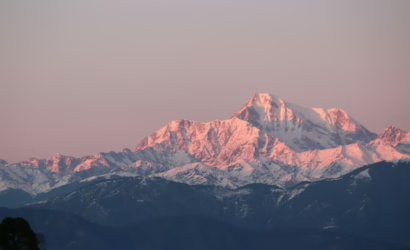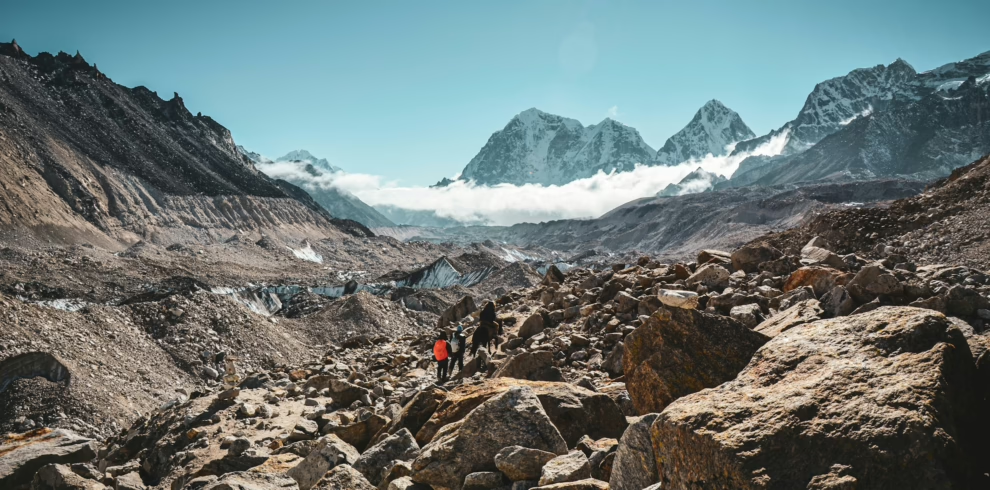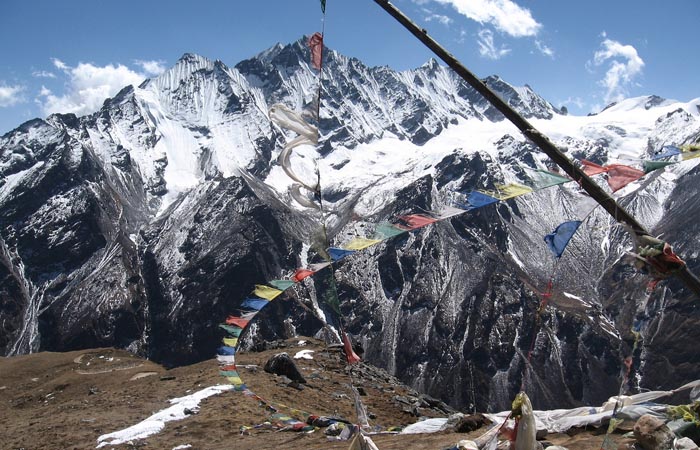Looking for a trekking experience that goes beyond the ordinary? The Tsum Valley Trek invites you into one of Nepal’s best-kept secrets—a secluded Himalayan haven where breathtaking scenery meets ancient culture.
Tucked away in the remote Gorkha district and encircled by the majestic Ganesh Himal, Sringi Himal, and Boudha Himal ranges, Tsum Valley offers a rare escape into untouched nature and living tradition. Its name, derived from the Tibetan word ‘Tsum’ meaning vivid, perfectly captures the valley’s colorful landscapes and rich spiritual heritage.
Unlike the more crowded trails of the Himalayas, Tsum Valley remains a peaceful retreat where time seems to stand still. Here, you’ll walk through serene alpine forests, cross crystal-clear streams, and gaze at dramatic mountain vistas—all while immersing yourself in a vibrant Tibetan Buddhist culture.
This trek isn’t just about the views—it’s a journey into a way of life preserved for centuries. Visit ancient monasteries perched on hillsides, share smiles with warm-hearted locals, and witness traditions passed down through generations. For those seeking connection—both with nature and a deeply spiritual culture—the Tsum Valley Trek offers an unforgettable adventure.
Overview
One of the main highlights of the Tsum Valley Trek is its stunning natural beauty. The trail winds through lush forests, high mountain passes, and rolling hills dotted with traditional villages. Along the way, trekkers may encounter Himalayan wildlife, such as the black bear, Himalayan tahr, and a variety of bird species.
This moderate to challenging trek requires good physical fitness and typically takes 14 to 16 days. The best seasons for the trek are from September to November and March to May, when the weather is most favorable. However, as mountain conditions can be unpredictable and terrain demanding, proper preparation is essential.
15-Day Tsum Valley Trek Itinerary
Your adventure begins with a scenic drive from Kathmandu to Soti Khola. From there, you’ll follow the Budhi Gandaki River northward, passing through forests of rhododendron and pine. The route leads to Machha Khola and then Jagat, before heading to Lokpa—the gateway to Tsum Valley.
From Lokpa, you’ll trek north to Chumling, home to three important monasteries: Pango Gumba, Gurwa Gumba, and Mani Dhungyur. This village also offers spectacular views of Manaslu (8,163m), Himal Chuli (7,893m), and Ganesh Himal.
Leaving Chumling (Lower Tsum), you’ll ascend through Domje—the largest village in the valley—to reach Chhokangparo (Upper Tsum). As the trail climbs, subtropical forests give way to high-altitude desert landscapes.
Using a detailed trek map, you’ll continue north from Chhokangparo, passing the Milarepa Piren Phu Cave and Phurbe, eventually arriving at the Nile. After an overnight stay, you’ll hike to Mu Gompa, the northernmost point of the trek, known for its spiritual significance and links to Guru Milarepa’s meditations.
The return journey takes a slightly different route. From Mu Gompa, you’ll descend to Rachen Gompa, then continue south to Domje. From there, a left turn leads back to Chumling. You’ll retrace your steps through Lokpa and Jagat, then travel through Lapu Bensi before reaching Soti Khola. The trek ends with a local bus ride back to Kathmandu.
At Green Lotus Trekking Pvt. Ltd, we’re proud to offer a carefully crafted Tsum Valley Trek itinerary that promises an unforgettable journey. Bookings for 2025 and 2026 are now open. We also offer customizable packages to fit your schedule, budget, and fitness level.
For pricing and more information, feel free to contact us anytime.
Benefits of Booking the Tsum Valley Trek with Us
- Complimentary airport pick-up and drop-off (international and domestic)
- Free Tsum Valley Trek map
- Oximeter for monitoring blood oxygen levels
- Basic medical kit for emergencies
- Free storage for excess luggage at our office during the trek
What to Expect on the Tsum Valley Trek?
The Tsum Valley Trek offers a unique and rewarding experience for adventurous trekkers. Here’s what you can look forward to:
- Stunning Mountain Views: Admire breathtaking panoramas of Ganesh Himal, Sringi Himal, and Boudha Himal.
- Cultural Exploration: Visit ancient monasteries and traditional villages, and learn about the valley’s rich Tibetan Buddhist heritage.
- Peaceful Natural Setting: Trek through serene forests and rolling hills, far from the crowded trails.
- Wildlife Encounters: Spot Himalayan black bears, Himalayan tahrs, and a variety of bird species.
- Challenging Terrain: The trek is moderately to highly demanding and requires good physical and mental fitness.
- Hidden Gem: As one of Nepal’s lesser-known trekking destinations, Tsum Valley offers a rare, off-the-beaten-path adventure.
Is the Tsum Valley Trek Right for You?
This trek is ideal for those who:
- Enjoy Physical Challenges: You should be in good shape and ready for long days of hiking.
- Love Nature: The route takes you through forests, hills, and mountain passes in a pristine setting.
- Value Culture and History: Discover a thriving Tibetan Buddhist community and centuries-old monasteries.
- Seek Solitude and Adventure: The valley is remote and peaceful, perfect for those looking to escape the crowds.
- Appreciate Natural Beauty: Expect scenic landscapes and awe-inspiring Himalayan views.
- Prefer Tranquility: The area’s quiet, spiritual atmosphere is a welcome retreat from daily life.
If this sounds like you, the Tsum Valley Trek is likely a great fit. Just keep in mind that preparation is essential due to the challenging terrain and unpredictable weather.
How to Prepare for the Tsum Valley Trek?
To make the most of your trek, consider the following preparation tips:
- Get Fit: Engage in regular cardio and strength training to build stamina and endurance.
- Pack Smart: Bring essential trekking gear, including proper footwear, layered clothing, a backpack, sleeping bag, and first aid kit.
- Secure Travel Insurance: Choose a policy that covers medical emergencies, altitude-related illness, and evacuation.
- Obtain Permits: Make sure you have the required permits issued by the Nepalese government.
- Acclimatize: Spend a few days in Kathmandu or a similar altitude to adjust before beginning the trek.
- Hire a Guide: An experienced guide can enhance your safety and understanding of local culture and trails.
- Travel Light: Only pack what’s necessary, as you’ll be carrying your gear throughout the journey.
With the right preparation, the Tsum Valley Trek can be a safe, enriching, and unforgettable adventure.
Useful Information for the Tsum Valley Trek
Best Time to Trek Tsum Valley
The ideal seasons for the Tsum Valley Trek are:
- Autumn (September to November): Clear skies, mild temperatures, and excellent mountain views.
- Spring (March to May): Warmer weather with blooming flowers and lush landscapes.
Avoid trekking during the monsoon season (July–August) due to heavy rainfall, slippery trails, and potential landslides. Even in peak seasons, temperatures at high altitudes can be cold, so pack accordingly.
Meals on the Tsum Valley Trek
As you ascend to higher altitudes, meal options become limited and more expensive. However, you will receive nutritious, energy-rich meals throughout the trek:
- Included Meals: 13 breakfasts, 12 lunches, and 12 dinners.
- Cuisine Options: Nepali, Asian, and Western dishes.
Sample Menu:
- Breakfast: Oatmeal, French toast, Tibetan bread, Tsampa porridge, eggs, pancakes, fruits, hot drinks.
- Lunch & Dinner: Dal Bhat, soups, Sherpa stew, momo, noodles, pasta, vegetable curry, sandwiches, pizza, and local specialties.
Accommodation
- In Kathmandu: 3-star hotel with bed and breakfast.
- During Trek: Twin-sharing rooms in teahouses or lodges. Attached bathrooms are common at lower elevations but rare higher up.
- Note: Facilities become more basic at higher altitudes. Rooms include foam mattresses, pillows, and blankets. Bring your own sleeping bag for extra warmth.
Trek Difficulty
The Tsum Valley Trek is moderately to highly challenging due to:
- Altitude: Elevations exceed 3,500 meters.
- Trek Duration: Typically 14–16 days, requiring good stamina.
- Trail Conditions: Steep, uneven, and occasionally rugged paths.
- Weather: Rapid changes with cold nights.
- Acclimatization: Gradual altitude gain is essential to prevent sickness.
Fit, adventurous trekkers who are well-prepared will find this trek highly rewarding.
Travel Insurance Requirement
Comprehensive travel insurance is mandatory. It should cover:
- Medical emergencies and evacuation (including helicopter rescue).
- Trip cancellations or delays.
- Natural disasters (e.g., landslides, avalanches).
- Lost or stolen gear.
Keep a digital and printed copy of your insurance documents with you at all times.
Altitude Sickness & Remedies
Altitude sickness is a real concern above 2,500 meters. Preventive measures include:
- Gradual ascent and proper acclimatization.
- Staying hydrated; avoid alcohol and caffeine.
- Eating high-carbohydrate meals.
- Resting adequately in early trek days.
- Medication: Consider taking Diamox after consulting a doctor.
- Oxygen: Portable canisters are helpful in emergencies.
If symptoms persist, descend immediately and seek medical help.
Packing List
Essential items for the Tsum Valley Trek:
- Backpack (50L+), Sleeping bag (rated -10°C or lower)
- Clothing: Layers including fleece, down jacket, insulated pants, rain gear
- Footwear: Waterproof hiking boots
- Accessories: Warm hat, sunhat, sunglasses, gloves
- Personal Items: Toiletries, water bottles, purification tablets
- First Aid Kit: Basic supplies and personal medications
Pack light but ensure all essentials are included to minimize fatigue and maximize comfort.
Trek Guide & Safety
Hiring a licensed guide is highly recommended for:
- Navigational support and local insights
- Cultural explanations and language translation
- Emergency assistance
Choose a guide who:
- Has experience in the Tsum Valley region
- Holds certifications (e.g., First Aid)
- Is knowledgeable, friendly, and communicative
Safety Tips:
- Be aware of altitude sickness symptoms.
- Monitor weather forecasts and prepare for sudden changes.
- Trek in groups when possible.
- Keep valuables secure and avoid trekking at night.
Booking the Tsum Valley Trek
Green Lotus Trekking offers affordable and flexible booking options for the Tsum Valley Trek. We are:
- Government-registered
- Affiliated with NTB, TAAN, NMA, and other tourism bodies
- Known for expert local guides and excellent service
Booking Process:
- Pay a 10% deposit to confirm your trek.
- Pay the remaining balance upon arrival in Nepal.
Join us for an unforgettable trekking adventure with a trusted, local company.
Highlights
- Explore remote trails in the Manaslu region, dotted with chortens, monasteries, and ancient gompas.
- Discover the secluded Tsum Valley and experience its deep-rooted Tibetan Buddhist culture.
- Enjoy panoramic views of Hiunchuli, Ganesh Himal, Manaslu, and the Poshyop Glacier from high mountain viewpoints.
- Cross suspension bridges, pass cascading waterfalls, and follow rivers through dramatic Himalayan landscapes.
- Interact with locals and lamas, and learn about their traditional lifestyle, ancient Buddhist monasteries, nunneries, and Mani walls.
- Visit sacred meditation caves once used by Milarepa and Guru Rinpoche in this spiritually rich hidden valley.
- Immerse yourself in a region that’s both culturally unique and geographically stunning.
- Meet the Tsumbas, an ethnic group of Tibetan descent, whose language, dress, and customs reflect their heritage.
- Experience the peaceful coexistence of culture and nature, protected by Buddhist principles that prohibit hunting and preserve local wildlife.







